AI Insight
Unlocking High-Stakes Decisions with Reasoning AI Agents: Deep Dive into Architectures, Trade-Offs & Real-World Impact
Explore how PT Solutions’ reasoning-powered AI agents transform complex decision making. From compute-cost trade-offs and chain-of-thought reasoning to healthcare, finance, logistics use cases and enterprise blueprints

Subscribe to our newsletter
Get the latest insights, articles, and updates from our team delivered straight to your inbox.
Related Articles
Ready to Transform Your Business?
Let's discuss how PT Software can help you achieve your digital transformation goals. Our team of experts is ready to create tailored solutions for your unique business needs.
Get Started Today


